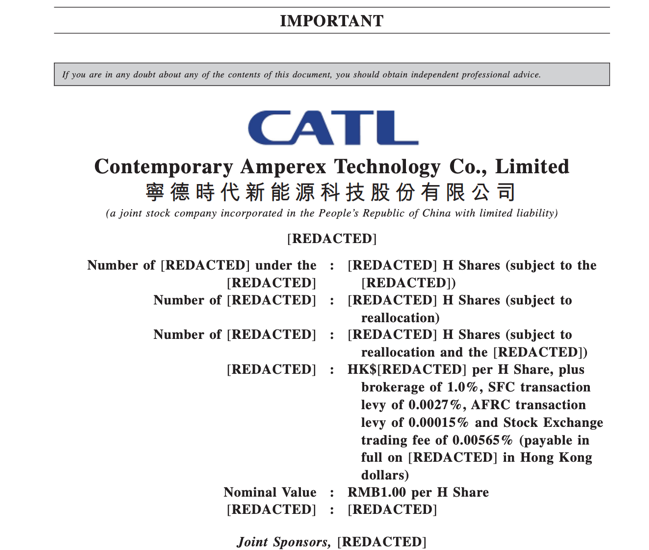How far will China’s President Xi Jinping go to achieve his stated desires for the year 2049?
2049 is an important year for China – it is the 100th anniversary of the founding of the People’s Republic of China; and Xi Jinping has announced his intention for the ‘great rejuvenation of the Chinese nation’ by that date.
It includes improving modern socialism within China, and ensuring China and the Chinese culture has its rightful place in the world. Methods include technology self-sufficiency, global influence (the Belt and Road Initiative is part of this), military strength, the ‘peaceful reunification’ of Taiwan, and economic prosperity.
Cyber is an important part of the process, but only a part. We’ll start with cyber and explore how it figures in achieving the great rejuvenation.
CATL is the world’s largest battery manufacturer. For example, it has almost 40% of the world’s electric vehicle (EV) market, including Tesla (those manufactured in China and exported from China), BMW, VW, Toyota, Hyundai, and Ford.
In January 2025, the Pentagon added CATL to its list of Chinese Military Companies with alleged ties to the Chinese military (the 1260H list). How can batteries be a threat to national security?
After years of claiming its batteries are effectively just dumb bricks, in January 2025 at WEF, CATL co-chairman Pan Jian declared the batteries were for EIVs (electric intelligent vehicles). “E enables I, and it allows us to offer consumers a whole host of new features that simply weren’t possible with a traditional internal combustion engine,” he said.
Suzanne Harrison, principal at Percipience LLC, advises organizations on how to maximize the value of their patents and IP, adds, “We found some documents on their website that clearly state that the battery management system connects to the CATL cloud, which makes them basically a pager on steroids.”

So, do CATL EV batteries contain spyware, and if so, what threat do they pose? The short answer is the potential for two-way communication between the battery management system and the CATL cloud, for which read the CCP.
“Like many PRC-developed systems,” comments Casey Ellis, the founder of Bugcrowd, “the existence of this kind of C2 begs a difficult-to-answer question of whether this type of functionality is a benign or even useful feature; something that has been inserted for the express purpose of espionage or disruption; or a dual-use ‘front-door’ intrusion that is intended to be benign until it’s not.”
Possible threats
The first and perhaps simplest threat is data collection. “If the battery is connected to something sensitive, the controller would know when it goes on, when it goes off,” says Ross Coffman, Lieutenant General Ret, and former deputy commanding general at Army Futures Command.
“A lot of intelligence can be gleaned from this simple data over time. The problem with clandestine operations collecting data is keeping the process clandestine. With batteries, the collection is hidden by occurring within the device itself.”
Ellis adds, “We know that the CCP has enormous capability when it comes to synthesizing intelligence out of otherwise benign-looking data – and it’s self-evident that an increase in power consumption at a military or intelligence facility, for example, is probably an early indicator of increased activity.”
Chris Gray, Field CTO at Deepwatch, adds, “From a cybersecurity perspective, however, the identified risks are tied to the potential harm incurred by the presence of these systems. With the rise of “intelligent” capabilities (including cameras, radar, LiDAR, and AI driver assist systems (ADAS)), fears exist for extended monitoring of vehicle and owner activities and installing malware on EVs and their associated charging infrastructure, providing further access for gathering intelligence and espionage activities.”
If data can be uploaded from the battery to China, could malware be downloaded from China to the battery? Could they all be terminated simultaneously? “Yes, probably,” says Peter Harter, attorney and a founder at Injustice Pool and The Farrington Group.
Could they be made to explode like Hezbollah’s remotely triggered pagers and walkie-talkies in 2024? “Yes, they can,” adds Harter, referencing the technical specifications of the batteries.
The potential mass disruption of vehicles could seriously limit the ability to respond to a major incident. But this is only the beginning of the threat. CATL doesn’t simply manufacture electric vehicle batteries: its batteries are used in industrial applications, consumer electronics, electrified rail systems, and – perhaps most notably – the electricity grid.

On March 5, 2025, Dr. Emma Stewart, Chief Power Grid Scientist at Idaho National Laboratory, provided testimony (PDF) to the select committee on the CCP. In it she notes the preponderance of China-manufactured battery energy storage systems (BESS) in the US grid, and the absence of US alternatives. In the same paper, she also discusses the cyber activity of Volt Typhoon and Salt Typhoon. “The growing threat to the critical functions of our infrastructure is demonstrated through reports on Volt Typhoon and Salt Typhoon, which describe capabilities ranging from pre-positioning access to our water, power, and gas in Volt and intrusion, mass data collection, and espionage on our critical communications infrastructure with Salt.”
Not specifically linked, but the adjacency is compelling, she also comments, “The removal of the Contemporary Amperex Technology Co., Limited, or CATL, battery from Camp Lejeune in late 2024 made a clear statement that we as a country would not continue to enable this front door intrusion.” But, she adds, “At present, removal of all these technologies would damage our resilience and reliability and detract from our ability to grow a US-dominant supply chain.”
There is always the possibility that there is no malicious intent in China’s prepositioning against the US energy system (plus the US internal military mobilization capability in the event of a national emergency) – that’s a question for the risk analysts. However, Ellis adds, “Cloud callback functionality could be leveraged to provide remote access to a system. In the case of a power management system, which is not only directly responsible for critical infrastructure but which also participates in the broader stability of the US power grid, the mere fact that systems like these have C2 back to a competitive nation-state is definitely cause for concern.”
Venky Raju, field CTO at ColorTokens, explains how the battery management systems included in CATL’s EV and BESS batteries could be abused via the C2. “This suddenly opens up a much wider attack surface as the connectivity between the battery packs and the cloud could be compromised, or the vendor’s backend systems are attacked and data is exfiltrated,” he suggests. Or, as the Pentagon seems to believe, everything will simply be passed to the CCP and the PLA.
Parametric data sent to the C2 is useful for nation state actors to understand power capacity, and utilization patterns that may be leveraged in attacks on the infrastructure. However, adds Raju, “In addition to being a passive backdoor for eavesdropping, the BMS could also be re-purposed as an attack point via an over-the-air upgrade, and used to stage CAN bus and Modbus-based attacks on adjacent systems.”
The Volt attackers simultaneously targeting the energy sector indicate a Chinese focus on energy systems, not necessarily limited to the US, but anywhere that these batteries are used. This could certainly be viewed as an aspect of, or step on the path toward, Xi Jinping’s plans for 2049.
But it’s difficult to prove. Heath Renfrow, CISO and co-founder at Fenix24, says, “Scrutiny is warranted. However, verifying the existence of spyware within their systems would require in-depth technical analysis. Similar concerns have been raised in the past regarding Huawei and other Chinese tech firms, where the challenge lies in proving intent and access rather than just capability.”
Coffman interjects, “We must assume these capabilities are real. And with an abundance of caution, we must assume that China is not acting in good faith until we can prove otherwise. The difficulty with these batteries is that once they are installed in cars, you can’t cut them off without destroying the car. And it’s the same with batteries installed in the energy sector.”
Can the ‘great rejuvenation of the Chinese nation’ be achieved by battery power alone? Probably not, but batteries are just one spoke in China’s armored wheel. China’s overall intention is to spread China’s way of thinking (Chinese influence and culture) until it dominates the world, while simultaneously achieving technological superiority, military strength and economic prosperity. It’s a form of Comintern updated and repurposed into PRCintern.
The influence and culture spoke has been apparent since 2013 with the Belt and Road Initiative (BRI). Its primary purpose is to enhance connectivity and cooperation across Asia, Africa, Europe and beyond. While this stated purpose is beneficial and lacks any direct threat, the effect is to spread China’s cultural influence and increase dependence on China, while improving the Chinese economy by enlarging its export market.
Another priority for Xi Jinping is to modernize China’s military. He has reduced the headcount of China’s standing army but is rapidly improving its fighting capabilities through more advanced technology. China’s military technology still lags western, and especially American technology – and this explains the PLA-centered state cyber groups targeting western-aligned defense organizations to steal military and defense related intellectual property.
This should raise alarms over the continuing intention toward Taiwan. The declared intent is for ‘peaceful re-unification’; that is, through economic and cultural means. If this fails, would China revert to force through using its increasing military strength? Would the same argument apply if Xi Jinping’s wider 2049 aspirations begin to fail? Either way, even if military strength is not used to gain global influence, it will be necessary to retain it.
The similarities between CATL and Huawei, and western concerns over both, should not be ignored. Both have been embedded into critical infrastructures, and both are accused of relaying data to the Chinese government. This suggests that the playbook of using low cost products to dominate western CNI is neither new, nor necessarily limited.
Harrison has examined CATL’s financial dealings and structure looking for clues, and believes that China is using the patent and IP system as a non-tariff weapon – and perhaps also funding the Chinese government. China’s economy is not as strong as it needs be to fulfill its various programs. “It has huge youth unemployment and a massive cash flow problem,” says Harrison. “The housing bubble is probably two to three times larger than the early 2000s bubble in the US, which led to the major global 2008 financial crisis. In China, the debt is held by state owned banks.”
If the banks can be supported by the government, a financial crisis can be averted; but only if the government can afford it. In 2018, CATL was listed on the Shenzhen stock exchange, raising around $850 million. A second listing in Hong Long is expected to close, possibly in May this year, and will likely raise $5 to $8 billion. Incidentally, in 2024 CATL’s financial statements reported $35.78 billion in existing cash reserves.
Harter believes that 40% of the proceeds will go straight to the CCP. “It might be more,” he says, “because of the opacity of the Hong Kong and Shenzhen exchanges. The CATL management is chock full of party members – and the primary purpose of CATL is to benefit the Chinese government and the Chinese military.”

Harrison believes that China manipulates the patent system to exaggerate the value of its companies. In CATL’s Hong Kong listing document, heavily and surprisingly redacted, the company claimed to hold “39,792 Patents Authorized/pending”. One month and three days later, this figure had jumped to 43,354. “The firm is pointing to its patent portfolio to show it is a true innovator. But within that portfolio there are many inconsistencies and falsities.”
Harrison chose to focus on CATL as an example of a playbook used by China. “It is being used in a variety of different industries, particularly around critical and emerging technologies. We should assume that there are many, many of these companies. CATL is just the easiest example of one we can see in the US market, but China is doing it around the world.”
China’s plan for 2049 is multifaceted. Everything we have discussed here is happening or has happened. These actions may or may not be coordinated – but we should assume they are at least related if not coordinated. The rejuvenation plan envisages a China that dominates the world culturally, economically, influentially, and militarily. This can only be achieved from a position of great strength in all these areas.
There is a huge difference between eastern and western cultures. While the individual-centric west demands instant results – gratification, if you like – the team-centered east can play the long game and accept collateral damage on the way; so long as the team wins in the end. China is playing a long game that is not easily discernible by the average westerner, and it is heavily cloaked with plausible deniability. We can see the individual threats but we don’t necessarily see the overall plan. Our failure to connect the dots is a recurring feature of our failures.
If this is a coordinated plan, we should learn that warfare doesn’t always rely on military conflicts (although it could). It doesn’t always rely on existing economic strength (strength can be increased and weakness can be disguised). But above all, we should learn that cyber is an important part of this warfare, if only a part. Nevertheless, cybersecurity is no longer distinguishable from national security.
Related: China-Linked ‘Velvet Ant’ Hackers Exploited Zero-Day on Cisco Nexus Switches
Related: Chinese Hackers Target Energy Firms in South China Sea
Related: China-Linked Winnti APT Group Silently Stole Trade Secrets for Years: Report
Related: The United States and China – A Different Kind of Cyberwar


